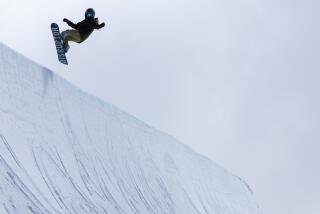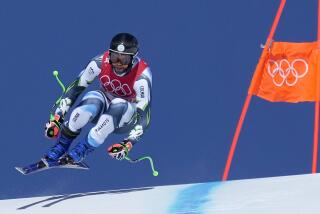Most Skiers Cool to Idea of Helmets
Bicyclists wear them, and many in-line skaters and skateboarders strap them on. But skiers? So far, only a small percentage wear protective helmets on the slopes.
But the Dec. 31 death of Michael Kennedy, who skied into a tree and suffered head and neck injuries, raises the question of whether skiers should start wearing helmets.
According to sources at local ski resorts, helmets are favored by a small percentage of people--mostly snowboarders and young children. Adult skiers rarely don the headgear, which resembles a bicycle helmet but offers more front and rear protection.
Some resorts donât even offer helmets in their rental shops, although more are beginning to do so. Helmets are available at regular ski, snowboard and sports equipment stores, where they retail for about $100 to $170.
The helmet trend is growing, however, fueled by more injuries, especially to snowboarders, who do more extreme, freestyle moves. Also, professional ski racers give helmets a decidedly cool look.
âWe donât see too many people up here wearing them, except for snowboarders,â says Chris Riddle, director of marketing at Snow Summit Mountain Resort at Big Bear Lake. âMore snowboarders are starting to wear them, especially the ones who do the extreme snowboarding, the freestylers who do the flips and jumps. Weâre also seeing more alpine [downhill] snowboarders wearing them. Itâs still a low number, Iâd say 15%, but itâs growing. Two or three years ago youâd actually be surprised to see someone with a helmet. The potential [for injury] is definitely there. If you catch the edge [of the board] the wrong way, you can slam pretty good.â
At Big Bear Lakeâs Bear Mountain Ski Resort, communications director Judi Bowers said she had noticed a gradual increase in helmet wearing until just last year, when there was a âbig jump,â due again to more snowboarding injuries.
But Bowers, like others in the industry, doesnât feel that Kennedyâs death will cause a run on helmets.
âHitting a tree is something that has happened before. This time it just happened to someone in the public eye. It may change a couple of peopleâs minds, but not the mass public,â she said.
The use of safety helmets in skiing is neither widely practiced nor recommended, ski experts say. The skiers who are most likely to wear helmets are skilled amateurs or professional freestyle or acrobatic skiers, says Bob Beeten, director of sports medicine for the U.S. Olympic Committee.
âI have heard very little about the use of ski helmets, although in freestyle competitions we do wear [them]. So there is a tinge of a trend in place,â he says.
Limb injuries are the most common result of ski accidents, but head injuries are typical of collision-type accidents, says Dr. Susan Ryan of the Denver Center for Sports Medicine.
She quoted a recent study of ski injuries, in which falls accounted for 75% to 85% of injuries while collisions with other skiers or trees caused 11% to 20% of injuries.
âFrom my experience working in emergency rooms in ski areas, the bulk of the head injuries occur from a collision with a tree,â Ryan says. âItâs usually young males skiing at higher speeds along the edge of the runs.â
As of now, no health organization or sports association has gone on record to recommend that skiers wear helmets.
âThere is so little to base an assumption [that ski helmets are necessary] on,â Beeten says. âThere would have to be a whole lot of research done.â
âI absolutely believe helmets are effective,â counters Ryan. âIn every sport where head injuries have played a role, weâve found that extra padding and helmets do provide protection.
âI think it would be appropriate for some organization to take the initiative and say we need to protect people. After all, this is a high-speed sport.â
But itâs not likely that any such recommendation will be made soon, Ryan says.
âI donât think this needs more study. But sometimes it takes someone to connect all the dots. Or it takes legal action to prompt a recommendation.â
*
Scott Wilson in the editorial library contributed to this story.
More to Read
Sign up for The Wild
Weâll help you find the best places to hike, bike and run, as well as the perfect silent spots for meditation and yoga.
You may occasionally receive promotional content from the Los Angeles Times.






